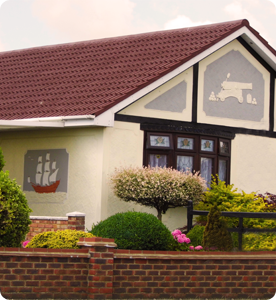How Important Is Your Roof?
Over the years our winters have become more and more harsh, very often lasting almost five months of the year. Your roof is exposed to the weather 365 days of the year. It is at constant risk as a result of wind, rain, gales, snow, frost and ice which can cause severe damage. Many roofs throughout the UK are affected.
Is your roof affected? Possibly more than you might have thought. Some people don’t have their roof inspected until it’s far too late and it's already leaking. At this stage the roof might be damaged beyond repair and require complete replacement where, for example, the batons may have decayed completely.




Insurance Companies Won’t Pay Out For Poor Maintenance
Some householders think they are covered by insurance if their roof develops a leak or if something happens. Insurance companies are finding new ways to avoid paying out on claims for damage to old roofs, stating in their terms and conditions ‘claim refused due to lack of maintenance’ for example. For instance, we as householders take moss for granted and some people think it won’t hurt or do any lasting damage to their roof, this is not the case, moss causes serious damage to roofs when it gets between the joints of your tiles.
When moss freezes it expands, this can cause frost damage or even crack or fracture the tiles. Some roofs might have over 20-50 years worth of dirt, moss, and lichen build up which can make the surface of the tile difficult to see clearly and therefore harder to spot any damage.
Our Surveyor’s Have A Trained Eye
Our Surveyors will be able to tell you if your roof tiles are cracked, they inspect and identify any loose mortar joints to ridges, hips, valleys and verges and leaking gutter joints. They will also check for gaps in the tiles - especially on roofing without felt.
The surveyor will also check for clogged guttering and damaged cement bedding to verge tiles. These are just a few of the things included in the report.
By having you roof inspected by a roofing expert, potential problems can be identified quickly before any major leaks occur. A roof report can prove cost effective in the long run, as well as providing the home owner with peace of mind.
We find that 86% of the people that we provide a report for will require some kind of repair work to be carried out,
& 48% of those come back to
us to have their roof renovated.
How Old Is Your Roof? SuperDry Roofing Offer Free Roof Reporting
SuperDry Roofing employ experienced roofing surveyors. Our surveyors are working & carrying out free reports on roofs throughout the region. The surveyors are paid a fee by the company and the report provided is free to the house-holder.
How does that work? Well it’s very simple. To qualify for a free report you must be a home owner or a long term tenant and the house must be over 15 years old. We must also have not carried out a survey on the property within the last 12 months. If all of these criteria are met, then your roof report is absolutely free.

What Happens Next?
On completion of the roof inspection the surveyor will discuss his findings with the property owner. If there is any roof damage or defects found, the surveyor will then provide a full report on the condition of the roof, he/she will also be able to point out any future potential problems and how to avoid the occurrence of them.
The surveyor will check your flat roof, the dormers, garage roof including bay window roof (if applicable) and also the house walls noting potential problems like cracks in plaster, defective rendering, face brickwork mortar joints, gutter outlets, back inlet gullies and drains, manhole covers and a general overview and what to do over the next five years to protect you and your family and save on future bills.
Who Pays The Company?
So how does the company make money? Householders will often get back in touch and ask SuperDry Roofing to carry out further work, like replacing a few tiles or even re-pointing the chimney for example. As a roofing company we have the expertise to cover a wide range of tasks and can complete whatever is required.
Health And Safety
For safety reasons our surveyors do not climb onto your roof. They carry visual aids (which include field glasses and zoom lens cameras), that allow them to record any possible roof defects accurately.
It's worth noting that some roofs will be provided with a clean bill of health. Maybe because they have been looked after, while other roofs will still naturally have some life left in them (for example, a flat roof might be good for a few more years), in such cases the house holder can request a free report update to be scheduled for the future. At the appropriate time, SuperDry Roofing will re-contact the customer to visit the property once more and provide the update.
Outside Roof Inspection
The surveyor will inspect a roof from the outside as long as they have a good unobstructed view of the roof from the top of your roof ridges to the bottom eaves.
The following checklist is an example of warning signs that the surveyors are looking for during an outside roof inspection for your report:
- Carefully check and note areas of moss & lichen, on tiles and the damage it has caused.
- Inspect for any missing cracked or fractured tiles or slates.
- Check tile surface decay as a result of frost damage
& moss & old age. - Check for gaps as a result of moss forcing joints apart or gaps in the mortar bedding of the ridge tiles caused by weathering.
- Check all hip tiles showing signs of wear and tear, cracked or missing mortar joints.
- Inspect for possible sagging on the ridges or if the centre of the ridge board lacks supports.
- On dormers and bays check for broken or loose vertical tiles at the slopes & hip lines, including cloaking at eaves.
- Carefully inspect for split or missing lead flashing and loose tiles in the valleys & defects to brickwork on gables & chimneys. Check verges for broken or missing sand & cement bedding including barge boards & fascia board condition.
- Carefully inspect front and rear gutters & all sides, check joints for leaks including clips & bracket spacing. Check roof ventilation points, inspect flat roof condition, excess water pooling, lead flashing & cover flashing abutment to main walls.
- Inspect house walls for evidence of cavity wall & cavity wall insulation, check the exterior plaster for any defects including horizontal or vertical cracking. Check face brickwork & mortar joints.
Inside Roof Inspection
The following checklist includes all the potential warning signs the surveyor will look for during an indoor roof inspection:
- Inspect felt between the rafters for splits and sagging due to debris or broken tiles/slates.
- Daylight visible through the tiles/slates, typically no felt on roof.
- Check for signs of leaking in the attic especially around vents, chimneys, and other spheres in the roof.
- Check roof timbers for signs of wood infestation, this may have been treated, so will check for fresh bore hole dust.
- Inspect for signs of condensation from poor roof ventilation.

